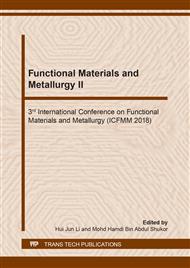[1]
S.I. Hong, C. Laird, Mechanism of slip mode modification in F.C.C. solid solutions, Acta Metall. Mater. 38 (1990) 1581-1594.
DOI: 10.1016/0956-7151(90)90126-2
Google Scholar
[2]
Z.R. Wang, Cyclic deformation response of planar-slip materials and a new criterion for the wavy-to-planar-slip transition, Philos. Mag. 84 (2004) 3-5.
DOI: 10.1080/14786430310001639824
Google Scholar
[3]
P. Li, S.X. Li, Z.G. Wang, Z.F. Zhang, Fundamental factors on formation mechanism of dislocation arrangements in cyclically deformed fcc single crystals, Prog. Mater. Sci. 56 (2011) 328-377.
DOI: 10.1016/j.pmatsci.2010.12.001
Google Scholar
[4]
Z.Y. Wang, D. Han, X.W. Li, Competitive effect of stacking fault energy and short-range clustering on the plastic deformation behavior of Cu-Ni alloys, Mater. Sci. Eng. A 679 (2017) 484-492.
DOI: 10.1016/j.msea.2016.10.064
Google Scholar
[5]
D. Han, Z.Y. Wang, Y. Yan, F. Shi, X.W. Li, A good strength-ductility match in Cu-Mn alloys with high stacking fault energies: Determinant effect of short range ordering, Scr. Mater. 133 (2017) 59-64.
DOI: 10.1016/j.scriptamat.2017.02.010
Google Scholar
[6]
C.B. Carter, I.L.F. Ray, On the stacking-fault energies of copper alloys, Philos. Mag. 35 (1977) 189-200.
Google Scholar
[7]
H. Saka, Y, Sueki, T. Imura, On the intrinsic temperature dependence of the stacking-fault energy in copper-aluminium alloys, Philos. Mag. A 37 (1978) 273-289.
DOI: 10.1080/01418617808235440
Google Scholar
[8]
R. Reihsner, W. Pfeiler, Atomic short-range order in CuMn alloys. J. Phys. Chem. Solids 46 (1985) 1431-1445.
DOI: 10.1016/0022-3697(85)90083-6
Google Scholar
[9]
R.A. Mulford, U.F. Kocks, New observations on the mechanisms of dynamic strain aging and of jerky flow, Acta Metall. 27 (1979) 1125-1134.
DOI: 10.1016/0001-6160(79)90130-5
Google Scholar
[10]
F. Springer, A. Nortmann, C. Schwink, A study of basic processes characterizing dynamic strain ageing, Phys. Stat. Sol. (a) 170 (1998) 63-81.
DOI: 10.1002/(sici)1521-396x(199811)170:1<63::aid-pssa63>3.0.co;2-f
Google Scholar
[11]
A. Nortmann, C. Schwink, Characteristics of dynamic strain ageing in binary f.c.c. copper alloys—II. Comparison and analysis of experiments on Cu-Al and Cu-Mn, Acta Mater. 45 (1997) 2051-2058.
DOI: 10.1016/s1359-6454(96)00293-5
Google Scholar
[12]
Y. Dastur, W. Leslie, Mechanism of work hardening in Hadfield manganese steel, Metall. Mater. Trans. A 12 (1981) 749-759.
DOI: 10.1007/bf02648339
Google Scholar
[13]
J.S. Ha, S.I. Hong, Temperature dependent slip mode modification in Cu-Al solid solution alloy single crystals, Mater. Sci. Eng. A 565 (2013) 9-12.
DOI: 10.1016/j.msea.2012.12.044
Google Scholar
[14]
S. Qu, X.H. An, H.J. Yang, C.X. Huang, Q.S. Zhang, Z.G. Wang, S.D. Wu, Z.F. Zhang, Microstructural evolution and mechanical properties of Cu-Al alloys subjected to equal channel angular pressing, Acta Metall. 57 (2009) 1586-1601.
DOI: 10.1016/j.actamat.2008.12.002
Google Scholar
[15]
X.H. An, Q.Y. Lin, S.D. Wu, Z.F. Zhang, R.B. Figueiredo, N. Gao, T.G. Langon, The influence of stacking fault energy on the mechanical properties of nanostructured Cu and Cu-Al alloys processed by high-pressure torsion, Scr. Mater. 64 (2011) 954-957.
DOI: 10.1016/j.scriptamat.2011.01.041
Google Scholar
[16]
V. Gerold and H.P. Karnthaler, On the origin of planar slip in F.C.C. alloys, Acta Metall. 37 (1989) 2177-2183.
DOI: 10.1016/0001-6160(89)90143-0
Google Scholar
[17]
S.H. Fu, Q.C. Zhang, Q. Hu, M. Gong, P.T. Cao, H.W. Liu, The influence of temperature on the PLC effect in Al-Mg alloy, Sci. Chin. Technol. Sci. 54 (2011) 1389-1393.
DOI: 10.1007/s11431-011-4398-9
Google Scholar
[18]
S.I. Hong, Influence of dynamic strain aging on the dislocation substructure in a uniaxial tension test, Mater. Sci. Eng. 79 (1986) 1-7.
DOI: 10.1016/0025-5416(86)90380-0
Google Scholar


